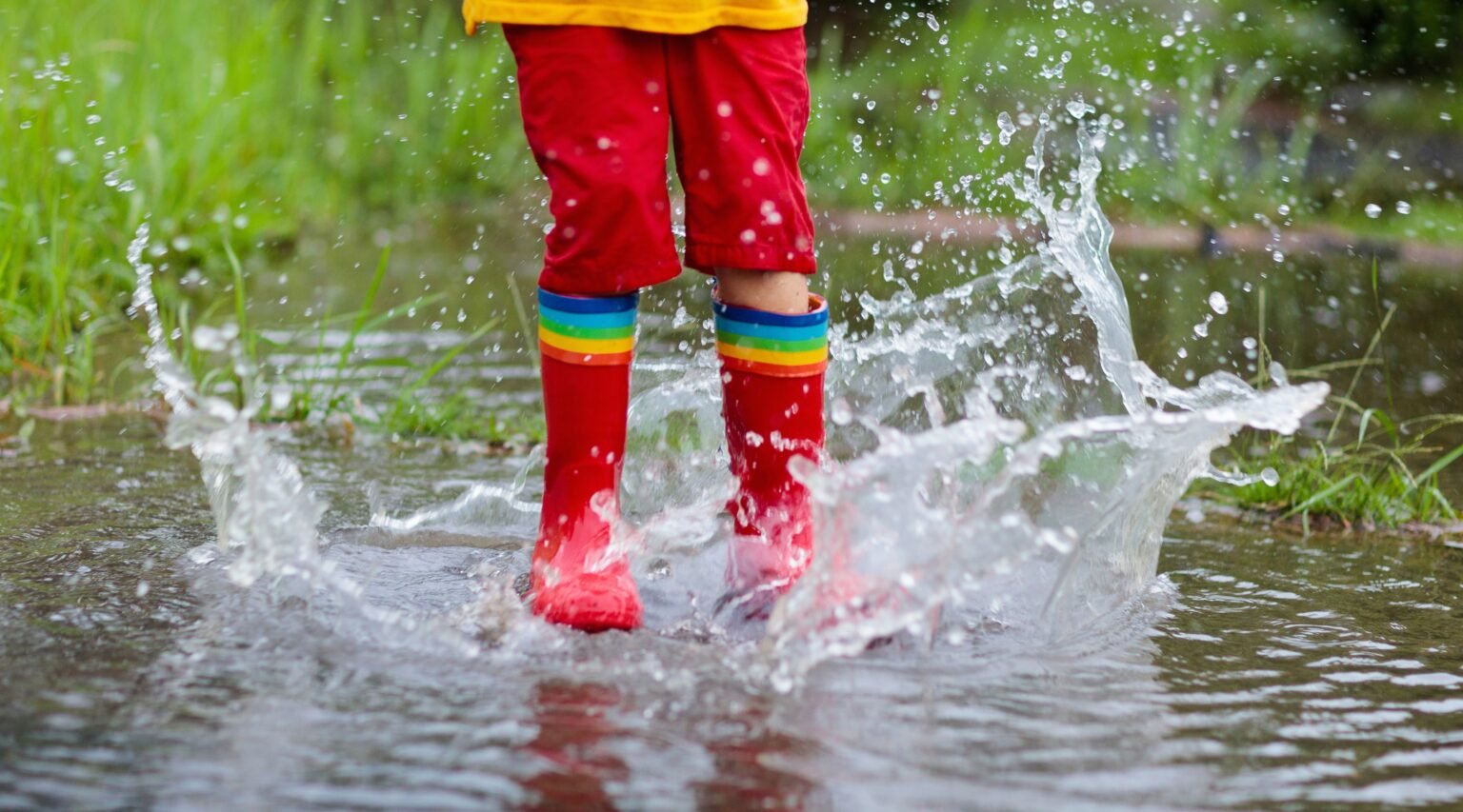
There is no such thing as bad weather, just wrong clothing
Dressing your child appropriately for all types of weather, ensures their small bodies need not divert extra energy towards regulating their internal temperature, thus allowing them to grow and play with vigor.
If you are new to every-day play outside, have no fear—you’re not alone! With a few simple essentials, and a general idea of how to layer gear and at what temperatures, your child will be as warm (and dry) as toast in no time!
-

The Essentials
Base Layer: Long johns or long underwear made of wool or wool/silk blend are best. As this layer is next to your child’s skin, it must be soft, breathable, and not trap moisture (like cotton).
Mid Layer: This is every-day clothing: pants, dress/skirt with leggings, short-sleeved shirt, long-sleeved shirt, socks, etc. Natural fibers like linen, wool, hemp, bamboo, and cotton are good fabrics to look for.
Extra Layer: Light coat, sweater, or warm vest, usually something that needs to fit under a coat, so again, wool is best as it adds warmth without adding excessive bulk (thus restricting movement). Good quality fleece is an option, though it is not always breathable and can overheat children, causing them to sweat which, in many circumstances, will leave them feeling chilled. This also means a single pair of thick wool socks, a lightweight hat that covers the ears, scarf or neck gaiter, and mittens. A wool/silk blend hood or balaclava is a great option as it fits under most hoods without much bulk and also covers the neck, ears, and cheeks.
Outer Layer (Rain/Wet): Waterproof boots that fit well (room for a thick pair of socks without squishing toes), rain pants or bibs, rain coat with hood, thicker wool mittens in damp conditions (which are still warm, even when damp), waterproof mittens in wet conditions, and a hat that fits under the hood. Rain gear isn’t just for rainy days; it’s also essential after rainy days when it is muddy and damp on the play yard. This layer will save you innumerable loads of laundry!
Outer Layer (Snow/Cold): Waterproof, insulated, snow boots that fit well with room for a thick wool sock. Waterproof snow pant bibs (at this age, too much snow/cold air can get up their backs with pull-on pant types) with a tight elastic cuff, cuff clips, or a bootstrap to prevent snow from getting in boots. Waterproof insulated mittens, a warm hat and scarf/ neck gaiter or wool hood, and a waterproof insulated coat with hood. Talk to some cold-weather experts if you’re unsure of what type of coat to look for. Often, the puffy coats we see from big-box retailers are filled with polyester and do very little for keeping warm. Look for natural down fill and Gore-Tex for a start.
-

Layers By Temperature
Above 60° — Mid Layer
60° to 50° — Base Layer + Mid Layer (or Mid Layer + Extra Layer)
50° to 40° — Base Layer + Mid Layer + Extra Layer
40° to 25° — Base Layer + Mid Layer + Outer Layer
Below 25° — Base Layer + Mid Layer + Extra Layer + Outer LayerKeep in mind this is a rough guide and all children are different. You know your child best: Do they run warm? Cold? In between?
My own son loves shorts, and as he typically runs warm, I know that by the afternoon he will be overheated in pants, even if the day starts at 50°.
I might send him wearing wool socks and leg warmers (that cover from ankle to mid-thigh, no exposed skin) under his shorts, so that he can peel off layers as the day progresses.
As a last note, a good measure of your child’s temperature is their neck and back, then hands.
Often when one takes off a layer, others insist they, too, are warm, when often it is more to do with imitating a friend.
-

Outdoor Gear Recommendations and Resources
***All classrooms will have extras of all the necessary gear in the case a student needs them.***
These boots will serve you through fall rain, winter snow and spring thaws. Make sure to get a size which allows for wool socks!
For children in the grades classes (not PreK or K) we advise you purchase a rain suit. These are designed to be used for multiple years. My children have had the same rain pants since they were 4.5 years old and they will turn 7 soon.
IMPORTANT: Red Granite will purchase 24 rain suits for both the PreK and K classrooms. If your child is in one of these classrooms you do not need to purchase a rain suit for them.
We recommend choosing waterproof pants versus water-resistant pants. Don’t be afraid to throw your rain pants over your snow pants!
Gloves/Mittens:
We recommend these be waterproof regardless of what season you intend to use them for.
Hats / Neck Warmers / Wool Socks
There are many options for these types of gear. Amazon is a fine place to go. I would be sure to purchase multiple pairs of wools socks per child.
General Outdoor Gear Resources
Polarn O. Pyret (online and in-store): Rain pants/ bibs/ coats, waterproof mittens, wool base layers, wool-blend base layers, snow gear
PuddleDucks (online): Rain pants/ bibs/ coats, rain boots, waterproof mittens
REI (online and in-store): Rain gear, snow gear, boots, wool socks (spring/summer clearance sales)
Obermeyer (online, REI and other sporting goods stores): Waterproof snow gear (Highly recommend! This will be my sons third year in the SAME coat and bibs. He is always warm AND dry, even in sloppy wet snow. He plays outside daily and rather vigorously… and no tears or rips, and still waterproof! All products have seams you can let out each year as your child grows to allow for multiple years of use.)
